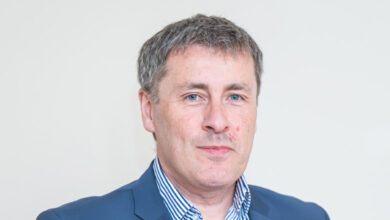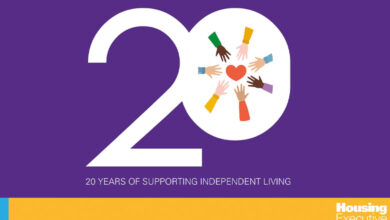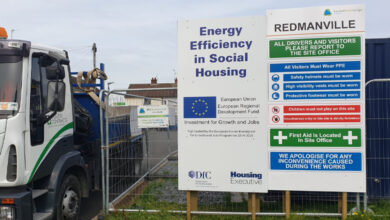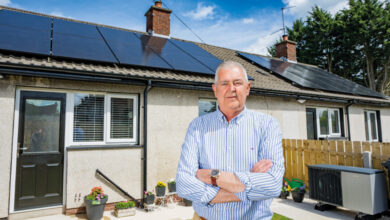Boosting recycling in Fife
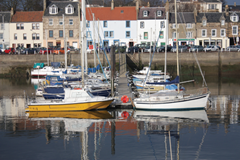 Recycling reached 67 per cent in the trial for Fife Council’s new household recycling system. Chris Ewing updates Peter Cheney on how it works and the importance of practical communication as plans take shape.
Recycling reached 67 per cent in the trial for Fife Council’s new household recycling system. Chris Ewing updates Peter Cheney on how it works and the importance of practical communication as plans take shape.
With around 365,000 residents, Fife has the third largest population of Scotland’s 32 council areas. Chris Ewing, the council’s environmental sustainability manager, has overseen a review of household waste and recycling, which started to roll out new services in September.
Most of the area’s waste comes from its 167,000 households. Fife has already
seen dramatic progress in household recycling, up from just 2 per cent in 2000 to 47 per cent in September 2010.
“Like many others, we’re learning as we go along but we have made some significant improvements in the last few years,” Ewing told agendaNi. From being the second worst performer in Scotland, it is now second best. “Things have moved on quite a bit but there’s still an awful lot
to do to meet Scottish Government targets, which is quite challenging.”
By 2020, 60 per cent of Scotland’s waste must be recycled or composted, rising to 70 per cent by 2025. Landfill must be reduced to 15 per cent by 2020 and 5 per cent by 2025.
Very few plastics were being recycled in Fife and no food waste was being collected for recycling and composting. It estimates that 35,000 tonnes of food waste per year is not picked up and a further 15-20,000 tonnes of cans and plastics could be collected on the kerbside.
“For the moment, the target areas for us are collecting more food waste, or collecting food waste for the first time, collecting a lot more cans and plastics but also, coupled with that, enormously reducing the amount of waste that we put to landfill,” Ewing commented.
Trial
A ‘member officer group’, consisting of councillors, officials and representatives from external organisations, was formed to review waste services. On current trends, the council would be paying nearly £25 million in landfill tax over five years. Ewing’s department was also facing an 18 per cent budget over the next three years.
The area has 360 recycling points, 11 recycling centres and a standard three-bin kerbside service:
• Brown for garden and food waste recycling (240 litres);
• Black for landfill (240 litres); and
• Blue for paper and cardboard recycling (140 litres).
Bins are collected fortnightly. During a trial in the Markinch area, from September 2009 to March 2010, the black and blue bins were swapped around so householders were limited to 140 litres of landfill. Collection times were also varied, so paper, cardboard, cans and plastics were collected weekly instead.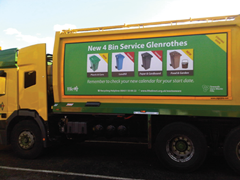
This resulted in a 67.5 per cent recycling rate. Ninety per cent of customers were satisfied with the performance, compared to an 80 per cent average. The group therefore decided to roll out the scheme across Fife, starting with Glenrothes in September 2010. It hopes to fully implement the scheme by March 2014.
Support from elected members was essential and the group was able to keep all political parties on the council on board. It also drew up a detailed communications plan, which accounted for most of the work in the roll-out.
Most of the communications work was targeted at householders, although it was also important to keep bin crews and depot staff informed.
Households first received a ‘teaser postcard’ 11 weeks before the roll out, which simply explained that an improved recycling service was “coming soon”. The postcards were designed to be as visible as possible and used real images of food and drink.
Public events started with 10 weeks to go, including visits to community councils, public information evenings, and stands at supermarkets and school gates. If people called with questions, staff would go out and visit them to explain the change.
A second postcard went out seven weeks in advance, explaining which bin should be used for each waste type. In the last month, a detailed information pack was sent out, including a leaflet on the bins and especially focusing on what should and should not go into the new green bin.
Other communication methods have included reminder tags on bins, vehicle advertising, an online bin calendar and facebook page, which picked up 962 hits over 10 days.
Recycling rates in Glenrothes reached 64 per cent in the first five weeks, according to the first estimates. It was previously around 38 percent. The first roll-out covers 22,000 houses and the council received 2,000 queries about the new service during that time. This does not equate to 2,000 households as the IT system logs each question from a resident as a separate query.
No magic bullet
It was almost impossible to do too much awareness-raising, according to Ewing, although there was some room for improvement in internal communication. The council also needed to streamline its process for handling requests for information. Ewing was also pleased with the work of the 12 recycling advisors who, for example, carried out the household visits.
“There isn’t a magic bullet,” he said. “There isn’t necessarily one best solution that fits all and that fits every council. So you’ve got to do a lot of things for yourselves. And we’re doing a lot of things for ourselves by way of feeling our way, by testing new approaches to potentially new systems, testing these on the ground for a period of time, and then taking a view to whether we should roll them out right across the council.”
Communication was two-way. “It’s not just about telling people what they have to do. It’s understanding what their issues are and what we need to do to try and motivate them and enable them to improve their waste management practices,” he added.
As for the magic bullet, he quipped: “When we find it, I think we’ll bottle it and sell it.”

